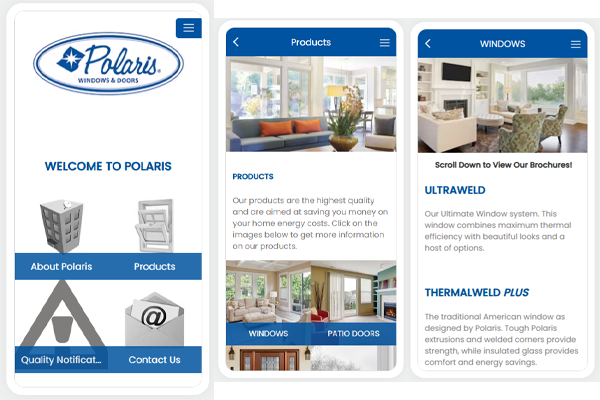Case Study: Polaris Mobile App
Creating Robust, Customized Mobile Experiences
A case study on the strategic redesign of the Polaris mobile application to create a dynamic, role-based platform that addressed critical inefficiencies across diverse user segments, from field sales reps to factory floor staff.
-67%
Reduction in Quote Time
Streamlined the sales process from 45+ minutes to under 15 minutes.
+240%
Increase in User Adoption
Grew monthly active users from less than 20% to 68% among field staff.
-18%
Reduction in Factory Defects
Leveraged real-time field data to improve production line quality.
A One-Size-Fits-None App
The existing app failed to provide critical tools for its primary users, leading to low adoption, costly errors, and major inefficiencies across our diverse business models.
Key Pain Points
The Legacy Experience (Pre-Redesign)

Complexity and feature sprawl defined the previous user experience.
Lack of Persona-Specific Workflows
A single, static interface for internal staff, dealer brands (White Label, Private Label, etc.), and homeowners meant critical tools were buried or missing entirely.
Manual & Inefficient Processes
Sales and dealer staff were forced to use outdated methods for quoting and ordering, while field teams delayed critical issue reporting until returning to the office.
High Error and Low Adoption Rates
The consequences were clear: less than 20% field user adoption, a 15% error rate in custom orders due to manual data entry, and a 45+ minute average quote time.
Research & Discovery
Defining Role-Based Needs
Our approach was rigorous discovery aimed at understanding the unique needs and permissions for each persona, which would dictate the strategic direction of the multi-tenant architecture.
Methodology
Comparative Product Review
We researched 3 mobile manufacturing apps to understand current design trends and identify potential contraints that could impact our own development.
Stakeholder Workshops
Conducted workshops with the Sales team and Engineering Department to align on business requirements and technical feasibility.
Synthesis & Persona Creation
We defined five primary role-based personas and prioritized workflows based on business impact.
Research validated the need to design for five distinct user paths. We focused on the Mobile Sales Rep as the highest leverage persona for initial impact.
Synthesis & Strategic Goal
Persona Focus Example (Mark, the Mobile Sales Rep)
When I am with a customer, I need a simple, validated tool to quickly configure a window quote so I can close the sale immediately without error.

Architecture: One App, Many Experiences
To avoid the cost and complexity of building separate apps, we implemented a smart architecture using a login selector and security tags to deliver customized, white-labeled experiences all from a single, manageable platform.
User Login
Selects Role/Dealer Type
Security Tag
Assigns Brand & Permissions
Custom UI
Shows Relevant Tools & Branding
Iterative Execution: The Flow Access Challenge
Early prototypes revealed unexpected complexity around custom accessibility and product exclusions, prompting multiple rounds of iteration and testing.
- Iteration 1 Failure: Our first approach used Buildfire’s ‘Tagging’ feature to assign custom app access for each client.
- The Pivot: During user testing, we discovered that users were seeing multiple, inconsistent versions of the app. Investigation revealed that the tagging system was propagating incorrect access permissions whenever users interacted with certain features. To resolve this, we replaced custom Tagging with a new system of Security Tags integrated directly with user registration data. This change ensured each user received accurate, secure, and consistent access across the entire app.

Validation & Testing: Proof Points Before Launch
Validation was a continuous process. We rigorously tested key hypotheses to ensure the architectural strategy delivered on the promise of efficiency and clarity.
Usability Testing & Feedback
Phase: Usability Testing
Conducted on a high-fidelity prototype
Participants
4 Field Sales Reps and 3 Internal Staff
Key Finding
Users easily navigated streamlined flow. Testing confirmed
Critical Refinement
During testing, we discovered users desired customized branding. We began building custom White Label app iterations for high volume clients, giving them the ability to do on the job presentations and job quoting, increasing sales opportunities by 35%.
Qualitative Validation
“The old app didn’t provide any custom elements related to my brand, and I couldn’t access internal quoting tools. Now, the app is customized to me and gives me instant access to my quoting account on the job. That’s money back in my pocket.”
– Cary S, Integrity Windows
The Solution
A Dynamic, User-Centric Platform
By understanding the distinct needs of each user profile, we designed a flexible, role-based application that delivered the right tools and branding to the right partner at the right time.
Meeting Diverse User Needs
The Impact
Measurable Results
The new application delivered significant, quantifiable improvements across engagement, efficiency, and quality.
Field Staff Adoption (MAU)
Quote Generation Time (Minutes)
Order Rework & Factory Defects
Reflections & Lessons Learned
This project was a strategic success that yielded valuable, scalable lessons for future platform development and cross-functional collaboration.
Key Takeaways for Future Projects
Alignment Over Perfection
The multi-tenant architecture decision was a strategic compromise that required deep collaboration with the Sales team to balance user value and deployment cost, saving tens of thousands of dollars per White Label app version.
The Power of the Atomic System
Designing for disparate user roles reinforced the necessity of a robust, atomic design system to maintain consistency within a fluid UI.
Future Focus
If given more time, the next phase would be building out offline functionality for deep-field sales to capture an additional 20% gain in workflow efficiency through streamlined offline usability.